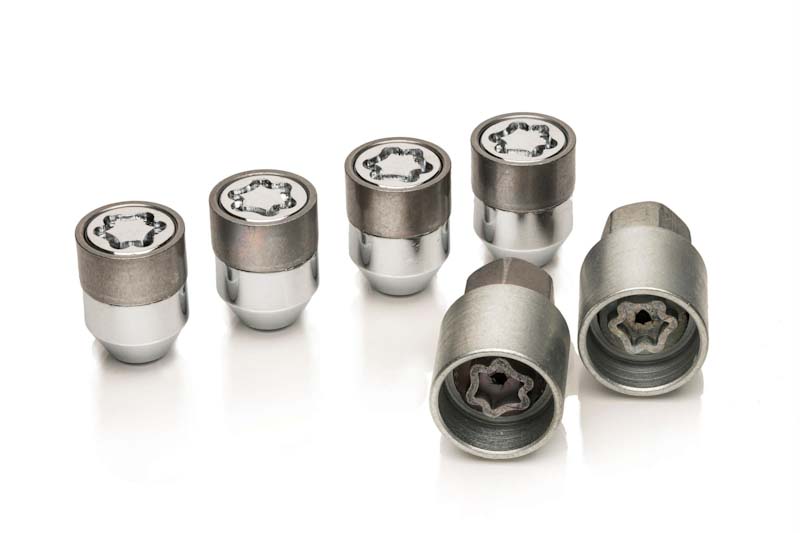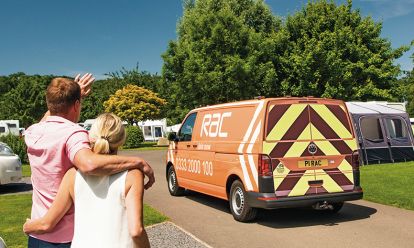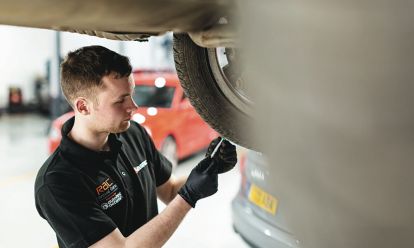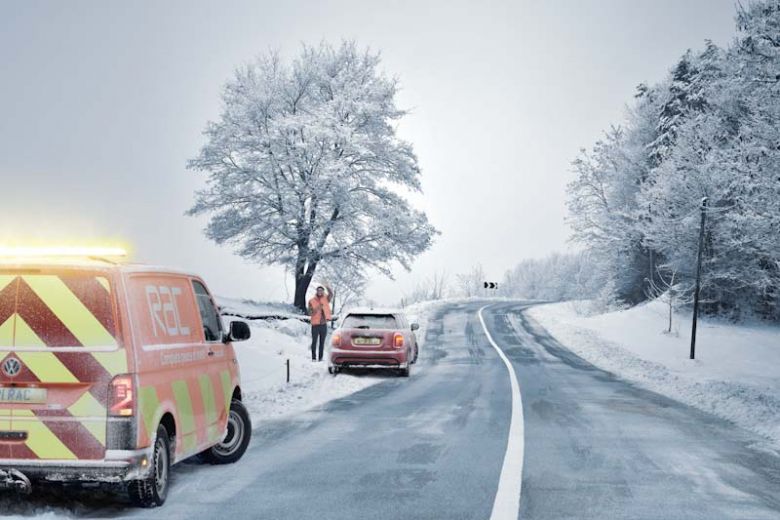The RAC sees a sharp increase in the volume of breakdowns when the weather turns cold, so it’s well worth taking the time to ensure you carry out the right checks on your car. Any underlying mechanical issues could escalate as temperatures plummet.
With a little care and preparation, you can avoid a costly breakdown this winter. Read our cold weather driving guide to keep safe and moving in the cold weather season.
Caravan or motorhome driver? Check out our specific advice for towing and motorhomes.


Quick winter driving checks before a journey
We suggest you remember and use the acronym FORCES for the regular ‘DIY checks’ you should carry out through the winter and especially as we head into another icy blast.
That's Fuel, Oil, Rubber, Coolant, Electrics, Screen wash
1. Fuel
Check you have plenty of fuel for your journey. It may sound obvious but you would be surprised how many people run out of fuel and with temperatures as low as expected you really don’t want get stranded. RAC Fuel Watch keeps track of the latest petrol and diesel prices.
If you drive an electric car, ensure you have sufficient battery charge for your journey and make a note of charging locations on your route so you can top up the battery if required. Charge Watch is the RAC's initiative that monitors the average cost of charging an electric car so that you get a fair price.
2. Oil
Our patrols check the oil level on every vehicle they attend and surprisingly they find one in three are dangerously low on oil. This can cause a breakdown or lead to catastrophic engine damage at worst.
You should check your oil level is between the minimum and maximum mark on your car's dipstick and top up if necessary. Knowing how to check your car's oil is a vital skill to have - especially when you have broken down in wintery conditions.
For the type of oil you need to use, you should refer to your owner’s handbook or speak to your local dealer.
3. Rubber
You'll need to check your tyres and your wiper blades before you set off.
Check your tyres for general wear and tear racks, cracks, splits or bulges, and most importantly, tread depth.
Although the minimum tread level is 1.6mm, during winter it’s advisable to have 3mm of tread on your tyres to help with traction and grip.
Also ensure that you have the correct pressure in your tyres - check your owner’s handbook for the correct inflation levels.
Your tyres are your car’s only connection to the road and it is vital that they are in good condition and correctly inflated for good traction and grip.
Next check your wiper blades. They are not everlasting and will need replacing from time-to-time, so check them for splits and cracks.

RAC sale – up to 33% off*
• Roadside cover from £5.29 a month†
• We get to most breakdowns in 60 mins or less
• Our patrols fix 4/5 breakdowns on the spot

Check whether they are effective at clearing your screen and replace as necessary.
Wiper blades can get frozen to the windscreen in freezing conditions and when there is snow. In colder winters, RAC patrols see a big increase in callouts to members' cars which have blown a fuse or broken the motor/mechanics when operating the wipers when they are frozen to the screen.
So clear your windscreen and ensure that they will lift off the screen before switching them on. Use de-icer or warm water (never hot water) to free them if necessary.
Cover your windscreen with a blanket or an old sheet to keep it ice and snow free and wrap the wipers up in the sheet to avoid them sticking to the screen. Or place a strip of plastic or card between the blades and the glass.
4. Coolant
Check your car’s coolant level. The last thing you need is a frozen engine or for your car to overheat.
Although it’s a sealed system and shouldn’t need to be topped up, you should always double check, especially before a long journey.
Check your coolant levels when the engine is cold and look in your handbook for the correct coolant and mix to use should you need to top it up.
5. Electrics
Check your car's lights – they are essential for you to see and be seen.
It’s vitally important to make sure not only that you can see where you’re going but also that other drivers can see you. Walk around your car and make sure all lights are working and that they are free from dirt, grime and snow.
Lights get extremely dirty during the winter months so clean them on a regular basis.
With a cold engine, check the battery terminals under the bonnet are clean and tight.
If your car struggles to start and the engine ‘labours’ when you turn the key you should get it checked by a garage. If your battery is over four years old it may be getting to the end of its life and it could let you down.
If you are having your battery tested, ask a garage to check the charging system and the drain on your battery – this will give a better picture of your car’s overall electrical health.
RAC patrols deal with over 400,000 battery related faults every winter as the cold weather takes its toll on older tired batteries and the wet and ice conditions play havoc with the electrics. Batteries have to work that much harder in cold conditions and they have endure greater demand from extra electrical equipment like the lights and the heater.
6. Screen wash
Check your screen wash level and top up with a quality screen wash additive or pre-mix which is effective down to at least -15 degrees celsius.
There’s more muck and dirt on the roads during the winter, as well as salt, so it’s important to make sure you can keep your windscreen clean. And remember to keep checking and topping up the level as you use the screenwash up.
In colder conditions, RAC patrols are called out to motorists whose screen wash has completely frozen in the tank – so it is vital that you remember to use a quality additive that protects down to very low temperatures.
What else to consider
In addition to the above checks, there are a number of symptoms your car can display letting you know something might need looking at. Carrying our regular checks to prevent a vehicle breakdown can make a huge difference.

Locking wheel nut key
These keys are designed to make sure that your wheel and alloys can't be stolen. However, they're also used to change your wheel or tyres following an issue. They are used to remove or tighten the wheel nuts.
Locking wheel nut keys are kept in a small bag or box within your vehicle. Normally, they're stored underneath the spare wheel in the boot, or in your glove compartment. In some models of cars, the bag or box is stored under one of the seats.
Make sure you know where these are, as you'll be asked to hand them over to a mechanic after a breakdown so they can try and resolve the problem with your car.
You'll need your locking wheel nut if you suffer from a flat tyre. Knowing how to change a tyre can help save time and get you to a garage to fix any other issues - should your vehicle have any.
Advice for towing and motorhomes
If you’re towing or driving a motorhome all the above advice is important; additionally, it’s worth considering replacing your battery before winter as you’ll be using extra heating and lighting which can take its toll. It’s also worth double-checking tyres they can deteriorate much more quickly than on vehicles that are used regularly.
In poor weather you’ll need to use even longer stopping distances than normal and take it slow, it’s worth considering not travelling if you have any concerns. Keep an eye on weather forecasts and if bridges are closed to high-sided vehicles, avoid that route if you’re towing or driving a motorhome.
Iain Geddes Senior Technical Adviser, The Camping and Caravanning Club, says: "Winter camping can be a wonderful experience, seeing a whole different side to the great outdoors. But if campers are concerned about hitting the roads in winter conditions, then specialist breakdown provision for caravan and motorhome owners with Arrival Breakdown Cover from the RAC is a great way to get peace of mind."
Arrival Breakdown Cover
Arrival is the RAC’s breakdown cover developed exclusively with The Camping and Caravanning Club. It includes everything that you’d expect from the RAC together with specialist benefits designed for caravans, motorhomes and campervans.


Preparing for a breakdown
However much you prepare, there’s always a chance that your car might leave you stranded over winter.
So it’s important to be covered and be fully prepared for a breakdown: keep warm clothes in your car, as well as a torch and a few basic tools. Consider keeping bottles of water in the car as well as emergency food supplies, such as energy bars and chocolate.
And if you are embarking on a long journey with snow forecast then be sure to pack extra waterproof, some sturdy footwear, a shovel, a warm drink in a flask and a fully charge mobile phone.
The best way to prepare for the cold weather is to prepare a winter breakdown kit checklist and to make sure you have breakdown cover in place before hitting the road.
Winter driving tips
These winter driving tips are a good place to start to help you prepare for driving in colder conditions.
- Your car is likely to use more fuel over winter. Don’t risk running the fuel tank low, as you could be vulnerable if you run out of fuel on a dark road or in bad weather.
- It’s especially important to plan your journey in advance if the weather is likely to be bad.
- Look at weather forecasts for a various locations on your route and consider taking an alternative route if particularly bad weather is forecast.
- Stick to main roads, as they’re more likely to be kept clear, and keep away from rural or hilly areas if possible.
- If you’re concerned that the weather is going to be bad enough to prevent you completing your journey, such as if weather warnings are in place, consider whether you’re journey is really necessary.
- Plan alternative routes in case you encounter an issue on your journey and keep friends and family informed of your location. You can share your location using apps such as Waze so people can kept track of your journey in case there’s an issue. Make sure your phone is charged in advance, and consider buying an in-car phone charger.
Driving in snow
This advice for driving in the snow helps set out a few key things to remember before you get behind the wheel.
- In snow and ice, stopping distances can increase by as much as 10 times compared to dry conditions.
- Drive slowly, allowing you to stop within the distance you can see in case of any obstacles in the road. Be smooth – braking, accelerating or turning harshly can unsettle the car, leading you to lose control.
- Keep the car clear of snow. All windows need to be clear for maximum visibility, while snow on the roof can fall and cause problems for you or other drivers. The number plates need to be visible, too.
Driving in rain
Driving in the rain can be challenging - so be prepared.
- Wet weather can be just as problematic as snow if you don’t drive to the conditions.
- Slow down, as stopping distances in the wet can be twice what they are in the dry.
- Watch out for flooding: dips in the road can hide areas of water, especially in the dark. If you’re not sure how deep a puddle is, don’t risk driving through it. Doing so could cause serious damage to your car and leave you stranded if it’s deep.
Driving in strong wind
If you're going to be driving in windy weather, then there are a few important things to consider.
- If there are weather warnings for strong wind, seriously consider whether your journey is absolutely necessary. Not only does it make driving difficult, trees are likely to come down causing congestion and, in a worst case scenario, hitting vehicles.
- If you do drive in strong winds, avoid high bridges, especially if you’re in a high-sided vehicle.
- If you feel the steering go light or you’re having to make a lot of corrections as the wind blows your car around, slow down and make sure you keep both hands on the wheel.
Driving in fog
Driving in the fog presents a unique challenge for drivers - and can be quite dangerous. Knowing when to use fog lights and the best ways to stay safe are important lessons for all drivers.
- Fog can also be especially dangerous. It usually accumulates in patches, so can take drivers by surprise.
- Switch your car’s fog lights on to aid your visibility to others, and increase the gap between you and the car in front. Above all, be prepared to stop within the distance you can see.
- If you’re driving through an urban area in thick fog, consider turning off the radio and opening the windows to help you listen for other vehicles.
Driving in low sun
All drivers who have got behind the wheel on a crisp winter morning or evening will have likely experienced piercing sunlight while driving.
- Surprisingly, this can be one of the biggest hazards for winter driving.
- Keep a pair of sunglasses in the car at all times, and use the sun visors if you’re driving when the sun is low. Keep your windscreen clean and slow down if visibility is reduced.
- Reduce your speed and give yourself more time when coming up to junctions to allow yourself the ability to correctly judge your surroundings.
Service, repair or MOT?
You can trust the RAC with our local approved garages and NEW mobile mechanics.


Advanced preparation for next winter
Cars need to be serviced regularly to keep them running well and this becomes even more important during the colder months.Getting a car serviced regularly reduces the chance of anything breaking, as you maintain your car, saving for a costly repair bill.
Check your car’s handbook or contact your dealer to find out the recommended service intervals.
If your car hasn't been serviced recently, consider booking it in for a service ahead of winter. Not only could a service prevent problems, a reputable garage should be able to spot issues on the horizon and give you advice to prevent a breakdown. Whether it is a full or interim service will depend on when your last annual service was.
Many car manufacturers offer special winter check deals that will check the key areas of your car important for safe winter driving.
Failing that at the very least you should perform the above basic checks.
Get 30 driving tips that will save you money
Running a car isn’t cheap, but there are some easy things you can do to keep your costs down. Get these tips and more useful driving articles sent straight to your inbox now.


















